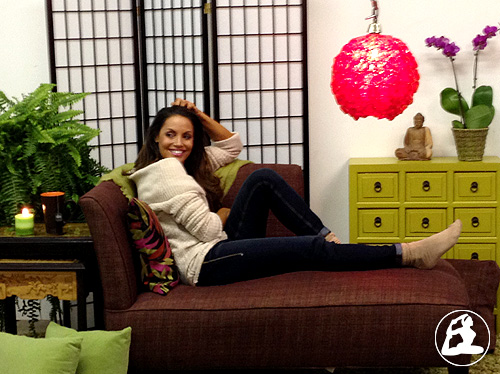Canadian Health & Lifestyle: A conversation with Trish Stratus

See more photos »By Barbara Goodman
Going into the wrestling world was an unusual choice for a woman. Was this a stretch or was it natural for you?
Actually, it was a completely natural move for me. I was such a tomboy. I grew up with my boy cousins, playing wrestling. We loved it so much! We'd go to Maple Leaf Gardens in Toronto to watch wrestling as often as we could. What I loved about wrestling then and now is that you get to entertain and be athletic at the same time.
Did you always want to be a professional wrestler?
No. I wanted to be a doctor. I was pre-med studying biology and kinesiology at York University. I loved science; I studied and played sports.
What was your inspiration for wanting to become a doctor?
Along with my exploratory nature, I wanted to help people. In high school I was very good at sports, so after practice I'd run drills with kids who wanted to improve. My nature is to help people out of their shell and get them inspired. As a doctor, I could help people get healthy. I had been on purpose with my plan but when the university professors went on strike, my plans were derailed.
Who was your role model for setting goals and achieving them?
My mom has been a huge influence. She'd set fitness goals and tackle them, whether it was getting into shape or doing a 10k run. She'd enter a race and we'd go watch her. My grandmother and all my aunts were all very strong women who influenced me too. And I've worked with strong, creative women, including the co-producers of the travel show Stratusphere. We went through our "bucket list" and travelled to amazing places, showcasing the ancient fighting arts of Iceland, Norway, Fiji, New Zealand and India.
You turned a passion into a TV show. Which country or fight form was the most surprising?
The history and culture of India really resonated with me, maybe because it's the birthplace of yoga. It's the most beautiful place I've seen. The muddy earth tones of the Himalayan Mountains, contrasted with the colourful saris of the Indian women. In Kerala, India, I learned ancient sword fighting techniques using heavy, sharp swords. It was an extremely different fighting form for me, doing an incredibly beautiful dance while wielding deadly swords.
How did you transition from pre-med to pro-wrestler?
The stars aligned at the right place and time. My motto is, "Preparedness makes opportunity." You never know when an opportunity will appear; being prepared allows you to take advantage and maximize it, then you won't have any regrets when the opportunity presents itself.
During the professors' strike, I was introduced to Robert Kennedy, the publisher of Oxygen magazine. He thought I had the right look for fitness modeling, an emerging industry that he pioneered, that used fit, healthy, feminine women as models. He suggested I take time to transform my body; six months later I did my first professional photo shoot. That was my first magazine cover – 94 covers ago.
After appearing on the TV sports talk show Off the Record an Internet rumour started that I was being scouted by Vince McMahon – which was false. But it perpetuated on the Internet and the next thing I knew, the WWE called me. I sent my press kit, and as I waited to see what would happen next I prepared myself.
How did you do that?
I learned how to wrestle. I went to a little downtown Toronto gym where fellow Canadian wrestler "Edge" trained. That's when I met my trainer Ron Hutchison. He laughed when I walked in – I was so tiny. He tried to discourage me with stories of this rough sport, but I still wanted to give it a shot and to his surprise I was a natural. When the WWE invited me to their headquarters for an interview, I was prepared. I had been training for six months. In 2000, I signed a contract and made my debut as a wrestler's manager.
Did you begin wrestling right away?
No. At the time, the traditional woman's role was as a manager. We walked the ramp in front of the male wrestler and were their speaking piece, but deep down inside, I wanted to be wrestling. I asked WWE trainer Fit Finlay to work with me; he was my mentor during my career. We'd train in the ring for hours before shows. In 2001 I got my shot when they brought back the women's division. I was ready and rocked it in the ring. And became WWE Women's Champion for the first time. There are a lot of wrestlers, but the WWE Superstars are sports entertainers – physically telling a story through wrestling. You have to take 20,000 people on an emotional ride with every move. The electricity in the building is wild. It's like a ballet, but really, really rough. The fans love it!
That's quite an accomplishment.
It's completely empowering. Strong women who are still feminine and beautiful, with a strong female voice, "making it" in a male-dominated sport.
You left wrestling due to an injury?
Yes. I've had black eyes, a broken nose three times – this isn't the same nose I started with. [She giggles.] But the most serious was a herniated disc that seized up on me; I had the neck of a 50-year-old. I couldn't sit for more than 30 minutes to fly on a plane, so forget about wrestling. At that point, in soap opera style, I was written off the storyline – smushed by a 500 lb wrestler.
Is this when you started doing yoga?
Yoga changed my life. It helped me recover from my back injury in three months. Not only was I able to go back to wrestling, it made me more agile – yoga helps me perform my best as a wrestler. I use it to manage stress in a very hectic life. I go internal and disconnect by having one-on-one time with me. It keeps me balanced. I have husband- and family-time. I work like crazy. I love what I do, I love creating, I love expanding and I love ideas.
What made you develop your yoga style?
When I got the role in the movie Bounty Hunters, I was doing my own fight stunts and my skinny yoga body wouldn't cut it.
I started using weights in my yoga practice to build muscle and core strength. So by integrating the fitness component into my yoga practice, I created Stratusphere Yoga. [Trish shares some routines in Pumped-up yoga.]
What's next for you?
My company's motto is, "Achieve wellness through balanced living." I want to bring this idea to people through the practice of yoga. I believe that if everyone did a little bit of yoga, the world would be a happier place. My passion is to provide the tools to make living a healthy and balanced life more accessible. The goal with all my career moves is to spread my message to a wider audience. I opened my yoga studio in 2008. Now the brand "Stratusphere" has expanded to retail with DVDs and a fitness product line.
Do you have a message for parents?
It's so important to get your kids into a sport they love, to help them find their passion. Sports taught me to be a leader, and a team member. I learned discipline and dedication. I've become who I am today because I played sports.
Additional thoughts for readers?
Go after everything you want with passion. Successful people do what they are passionate about, it drives them. I love yoga; now it's a business and product line. Take a risk. Ask yourself: "What do I love, and how can I work it into my life?" Whether it's by volunteering or doing something for yourself, do it every day and you can live out your passion. Visit trishstratus.com for much more.
RELATED STORIES
• Sweat Equity: Gurus in our midst
Want more?
Prev story Next story

